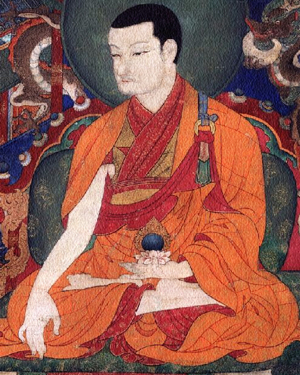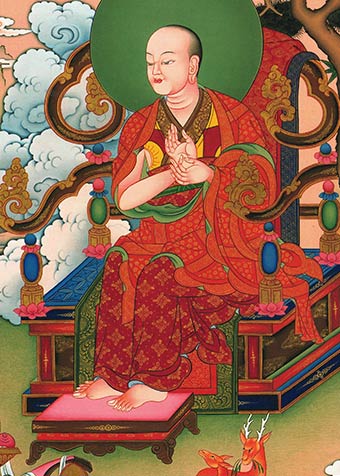Drogön Chögyal Phagpa (Tibetan འགྲོ་མགོན་ཆོས་རྒྱལ་འཕགས་པ་ the Victory Dharma King – Protector of Beings) was born amid excellent signs in the Wood Female Sheep year (1235). His father was Sönam Gyaltsen and his mother was Machig Kunga Kyi. He was given the name Lödro Gyaltsen (སོག་བཟློག་པ་བློ་གྲོས་རྒྱལ་མཚན་ Wisdom of the Victory Banner) at birth. He is the nephew of the Fourth Sakya Patriarch, Sakya Pandita.
Since very young, Chögyal Phagpa demonstrated outstanding intelligence and great knowledge in many areas, especially his ability of reading and writing in diverse scripts, without having been taught. For example, at the age of three, he recited the elaborate Hevajra sadhana by memory. Everyone present was very impressed and remarked that he was a true Phagpa (holy being). From then on, he was known as Phagpa and his fame was proclaimed everywhere.
He spent all his time attending Sakya Pandita during their travels and residence in China, until the age of seventeen, Chögyal Phagpa left for Mongolia on his uncle’s behalf. (The then Prince Kublai sent an invitation letter to Sakya Pandita requesting for a meeting, but Sakya Pandita was sick and thus was unable to make the trip. Instead Chögyal Phagpa made the trip for him.) Sakya Pandita was very pleased with Chögyal Phagpa for having mastered the outer and inner Vajrayana teachings, and thus gave him a white conch to proclaim the Dharma and a begging bowl. Having entrusted his students to Chögyal Phagpa, the master said, “The time has come for you to teach, to benefit many sentient beings, and to recall your promise.” Then Sakya Pandita passed away, having accomplished all he had intended to do. In this way, Chögyal Phagpa succeeded Sakya Pandita as the Seventh Sakya Trizin. He also became the Fifth Sakya Patriarch.
His Holiness the Sakya Trichen: How Vajrayana was Established in the Mongol Empire for the First Time
Later, Kublai Khan invited Chögyal Phagpa to Mongolia. Kublai Khan’s consort, Queen Chabi already developed an unshakable devotion to Chögyal Phagpa. However, Kublai Khan only perceived Chögyal Phagpa as an extremely intelligent and young noble scholar. Queen Chabi was very devoted to Chögyal Phagpa. She requested for the Hevajra Empowerment. After receiving the empowerment, she was so impressed by Chögyal Phagpa that she requested Kublai Khan to receive the same teaching as well.
However Kublai Khan asked, “To receive such teaching, what commitment do I have to make?” Chögyal Phapga replied, “If you receive the empowerment then whatever the Guru (Spiritual Teacher) command, you have to follow; you have to always respect him like your crown.” After listening, Kublai Khan announced, “I cannot follow such instruction because I am the Emperor. So I am not going to receive the empowerment.” Queen Chabi who is very intelligent and capable suggested, “There is actually a method to do so. If it is a religious ceremony, Lama (Master) Chögyal Phagpa should always sit on a higher throne. If it is for the secular ceremony, then the Emperor will sit on a higher throne. Methods related to Tibet, whatever Lama Phagpa says, we should follow, but as for other affairs, the Lama should not interfere. So with this kind of arrangement Your Majesty will be able to maintain your samaya (vows to uphold after receiving tantric teachings).”

Chögyal Phagpa gave the Hevajra Empowerment three times to the Kublai Khan and the Royal Family along with the inner circle of attendants in total of twenty five initiates each time. (According to the traditional practice of the Sakya Tradition, the Hevajra Empowerment may only be given to not more than twenty-five first-time initiates each time.) At the first empowerment, Kublai Khan offered the main parts of Tibet as the empowerment offering. Few years later, he offered the entire Tibet to Chögyal Phagpa at the second empowerment. In ancient China, there was a practice where those with disabilities were not allowed to live. Since the country had a huge population, the number of lives taken due to this practice was massive. Kublai Khan made a promise to cease this practice as an offering to Chögyal Phagpa during the third empowerment. In this way, the Vajrayana teaching was established for the first time in the Mongol Empire. Mahayana Buddhism was already introduced in the Mongol Empire and China, but not Vajrayana Buddhism.
Although Kublai Khan and his family have received many teachings from Chögyal Phagpa, his devotion is not comparable with Queen Chabi. Therefore Queen Chabi personally went to Chögyal Phagpa and requested, “Lama Rinpoche, in order to make firm the Emperor’s faith, please perform a miraculous feat. Unless you do so, there is the risk that his confidence will falter.” After she made the request for the third time, Chögyal Phagpa established Kublai Khan’s faith by performing miracles; he showed each of the Five Buddha Families separately by cutting open the five limbs of his body with a sharp sword. (Everyone present including Kublai Khan was extremely shocked to see this; Kublai Khan immediately urged his teacher to stop the scene and declared that now he had unshakable faith and devotion towards his Lama.)
Kublai Khan gave Chögyal Phagpa the title of “Tishri” (Imperial Preceptor) when Chögyal Phagpa was twenty-five. Kublai Khan suggested converting all the other Buddhist traditions to the Sakya tradition. Using the analogy of a table in which it can only function when all four legs exist, Chögyal Phagpa urged Kublai Khan to support, care, and propagate all the Buddhist traditions. Chögyal Phagpa has contributed immensely to the all traditions during that time.
Chögyal Phagpa spread the Dharma in Tibet, China, and Mongolia, and became an abbot of four hundred thousand monks. He gave teachings in many languages and benefited many people. He also composed many texts of commentaries, practical instructions, and questions and answers. Chögyal Phagpa also invented the “Phagpa Script”.
In the early morning of the twenty second day of the eleventh month of the Iron Male Dragon year (1280), when he was forty-five, having endeavored greatly to benefit others, Chögyal Phagpa sat cross-legged, holding his vajra and bell. With his arms crossed, and amid sounds, amazing scents, and a shower of flowers, he passed away.
His Holiness the Sakya Trichen: Not Only Chögyal Phagpa Was a Great Master, But a Real Buddha – Buddha in a Human Form
“At that time there were some who were critical about Chögyal Phagpa’s involvement in both religious and secular activities. So these people wanted to test him. When they were heading to see Chögyal Phagpa, they also saw some old arhats. Lord Buddha assigned these sixteen arhats to benefit sentient beings. These sixteen arhats are residing in different parts of the world propagating the Buddha Dharma. So during that time these sixteen arhats also came to great Chögyal Phagpa. Through seeing this, the doubt and confusion of those people was cleared. They now believed that not only Chögyal Phagpa was a great master, but a real Buddha – Buddha in a human form. In this way, we could see and learn how great Chögyal Phagpa was as a Buddha in person.”
– His Holiness the Sakya Trichen, 2018

